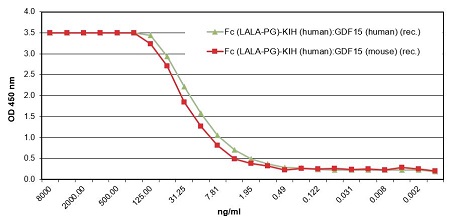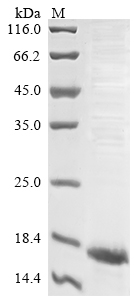
Fc (LALA-PG)-KIH (human):GDF15 (human) (rec.) (#AG-40B-0253) binds to its receptor GFRAL. Method: Mouse GFRAL is coated on an ELISA plate at 500 ng /ml overnight at room temperature. Fc (LALA-PG)-KIH (human):GDF15 (human) (rec.) or Fc (LALA-PG)-KIH (human):GDF15 (mouse) (rec.) (#AG-40B-0245), are added (starting at 8000 ng/ml with a two-fold serial dilution) during one hour and then detected using an anti-human Fc (HRP) antibody.
Fc (LALA-PG)-KIH (human):GDF15 (human) (rec.)
AG-40B-0253
Protein IDQ99988
Product group Proteins / Signaling Molecules
Overview
- SupplierAdipoGen Life Sciences
- Product NameFc (LALA-PG)-KIH (human):GDF15 (human) (rec.)
- Delivery Days Customer10
- CertificationResearch Use Only
- Concentration1 mg/ml
- Estimated Purity>95%
- Protein IDQ99988
- Protein NameGrowth/differentiation factor 15
- Scientific DescriptionGrowth and differentiation factor 15 (GDF15, also known as macrophage inhibitory cytokine-1 (MIC-1)), is a member of the transforming growth factor (TGF)-beta superfamily and was initially identified in activated macrophages. GDF15 acts through a recently identified receptor called Glial-derived Neurotrophic Factor (GDNF) Receptor Alpha-Like (GFRAL) which signals through the Rearranged during Transfection (RET) tyrosine kinase receptor. GDF15 is highly expressed in placenta and brain, and it is expressed at lower levels in kidney, pancreas, prostate and colon. Similar to other TGF-beta family proteins, GDF15 is synthesized as a large precursor protein that is cleaved to release the mature protein that shares 66% and 97% amino acid sequence identity with the human and rat proteins, respectively. Biologically active GDF15 is a disulfide-linked homodimer of the mature protein. The effects of GDF-15 are pleiotropic and include appetite regulation, actions on metabolism, pregnancy, cell survival, immune response and inflammation. GDF-15 also plays different roles in the pathophysiology of cardiovascular disease, autoimmunity, cancer-associated anorexia/cachexia and diabetes. High levels of GDF15 cause anorectic effects and cachexia, largely if not exclusively through the suppression of food intake via modulation of neuropeptide Y and pro-opiomelanocortin levels. Various functions have been reported for GDF15, including inhibition of TNF-alpha production from lipopolysaccharide-stimulated macrophages and the induction of cartilage formation. GDF15 promotes also neuronal survival. GFRAL and GDF15 signaling is implicated in diet-based obesity and insulin resistance. GDF15 is cardioprotective via inhibition of platelet activation, limiting atherosclerosis, promoting recovery following myocardial infarction and regulating angiogenesis. The protein Fc (LALA-PG)-KIH (human):GDF15 (human) (rec.) is produced by using two different vectors, one encoding for the Fc Knobs (LALA-PG) (human):GDF15 (human) sequence (synthesizing a protein of 47kDa) and one encoding for the Fc Holes (LALA-PG) sequence (synthesizing a protein of 30kDa). Both vectors transfected into HEK293 cells produce both Fc molecules (Knobs-into-Holes technology; J.B. Ridgway, et al.; Protein Eng. 9, 617 (1996)) required for dimerization and for secretion of the final protein Fc (LALA-PG)-KIH (human):GDF15 (human) (rec.). This Fc-KIH format allows our human GDF15 protein to form a dimer that is the most active structure to bind and activate the GFRAL and RET receptor complex. The LALA-PG mutations inhibit binding to FcgammaRs and C1q while FcRn binding and Fc stability remain unaffected. InVivoKines™ are a new generation of recombinant fusion proteins for immunotherapeutic, preclinical and translational in vivo research, developed and manufactured by AdipoGen Life Sciences. InVivoKines™ are a new generation of recombinant fusion proteins for immunotherapeutic, preclinical and translational in vivo research, developed and manufactured by AdipoGen Life Sciences. - InVivoKines™. Recombinant Protein. The extracellular domain of human GDF15 (aa 197-308) is fused to the C-terminus of the Fc (LALA-PG) Knob region of human IgG1. Fc (LALA-PG) Knobs:GDF15 (human) and Fc (LALA-PG) Holes form the Fc (LALA-PG)-KIH (human):GDF15 (human) (rec.) using the Knobs-into-Holes technology (see reference: J.B. Ridgway, et al.; Protein Eng. 9, 617 (1996)). Source: HEK 293 cells. Produced using animal component-free medium.. Binds to its receptor human (but also mouse) GDNF family receptor alpha-like (GFRAL) with an ED50 <15ng/ml. The Fc contains the mutations LALA-PG that abolish the interaction between the Fc and FcgammaRs and therefore Fc undesirable effects. Lyophilized. Contains PBS Growth and differentiation factor 15 (GDF15, also known as macrophage inhibitory cytokine-1 (MIC-1)), is a member of the transforming growth factor (TGF)-beta superfamily and was initially identified in activated macrophages. GDF15 acts through a recently identified receptor called Glial-derived Neurotrophic Factor (GDNF) Receptor Alpha-Like (GFRAL) which signals through the Rearranged during Transfection (RET) tyrosine kinase receptor. GDF15 is highly expressed in placenta and brain, and it is expressed at lower levels in kidney, pancreas, prostate and colon. Similar to other TGF-beta family proteins, GDF15 is synthesized as a large precursor protein that is cleaved to release the mature protein that shares 66% and 97% amino acid sequence identity with the human and rat proteins, respectively. Biologically active GDF15 is a disulfide-linked homodimer of the mature protein. The effects of GDF-15 are pleiotropic and include appetite regulation, actions on metabolism, pregnancy, cell survival, immune response and inflammation. GDF-15 also plays different roles in the pathophysiology of cardiovascular disease, autoimmunity, cancer-associated anorexia/cachexia and diabetes. High levels of GDF15 cause anorectic effects and cachexia, largely if not exclusively through the suppression of food intake via modulation of neuropeptide Y and pro-opiomelanocortin levels. Various functions have been reported for GDF15, including inhibition of TNF-alpha production from lipopolysaccharide-stimulated macrophages and the induction of cartilage formation. GDF15 promotes also neuronal survival. GFRAL and GDF15 signaling is implicated in diet-based obesity and insulin resistance. GDF15 is cardioprotective via inhibition of platelet activation, limiting atherosclerosis, promoting recovery following myocardial infarction and regulating angiogenesis. The protein Fc (LALA-PG)-KIH (human):GDF15 (human) (rec.) is produced by using two different vectors, one encoding for the Fc Knobs (LALA-PG) (human):GDF15 (human) sequence (synthesizing a protein of 47kDa) and one encoding for the Fc Holes (LALA-PG) sequence (synthesizing a protein of 30kDa). Both vectors transfected into HEK293 cells produce both Fc molecules (Knobs-into-Holes technology; J.B. Ridgway, et al.; Protein Eng. 9, 617 (1996)) required for dimerization and for secretion of the final protein Fc (LALA-PG)-KIH (human):GDF15 (human) (rec.). This Fc-KIH format allows our human GDF15 protein to form a dimer that is the most active structure to bind and activate the GFRAL and RET receptor complex. The LALA-PG mutations inhibit binding to FcgammaRs and C1q while FcRn binding and Fc stability remain unaffected. InVivoKines™ are a new generation of recombinant fusion proteins for immunotherapeutic, preclinical and translational in vivo research, developed and manufactured by AdipoGen Life Sciences.
- Storage Instruction-20°C,2°C to 8°C
- UNSPSC12352202



